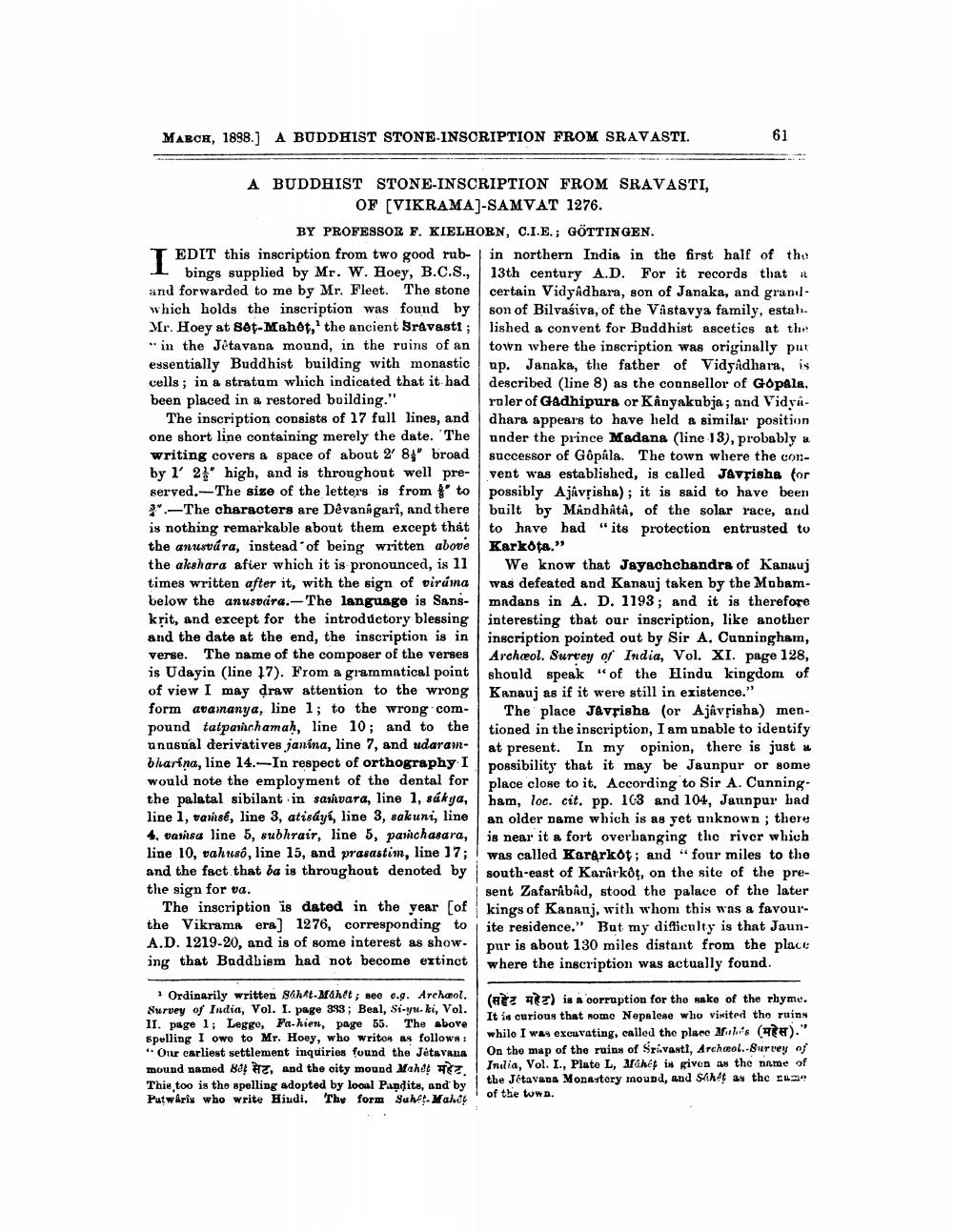________________
MARCH, 1898.) A BUDDHIST STONE-INSCRIPTION FROM SRAVASTI.
61
A BUDDHIST STONE-INSCRIPTION FROM SRAVASTI,
OF [VIKRAMA]-SAMVAT 1276.
BY PROFESSOR F. KIELHORN, C.I.E.; GÖTTINGEN. T EDIT this inscription from two good rub- in northern India in the first half of the 1 bings supplied by Mr. W. Hoey, B.C.S., 13th century A.D. For it records that it and forwarded to me by Mr. Fleet. The stone certain Vidyadhara, son of Janaka, and grandwhich holds the inscription was found by son of Bilvasiva, of the Vastavya family, estah. Mr. Hoey at Set-Mahot,' the ancient Sravasti ; lished a convent for Buddhist ascetics at the
in the Jētavana mound, in the ruins of an town where the inscription was originally put essentially Buddhist building with monastic up. Janaka, the father of Vidyadhara, is cells; in a stratum which indicated that it had described (line 8) as the counsellor of Gopala, been placed in a restored building."
ruler of Gadhipura or Kânyakubja; and VidyaThe inscription consists of 17 full lines, and dhara appears to have held a similar position one short line containing merely the date. "The under the prince Madana (line 13), probably a writing covers a space of about 2 8' broad successor of Gopala. The town where the conby 1' 2high, and is throughout well pre- vent was established, is called Javrisha for served. The size of the letters is from to possibly Ajávộisha); it is said to have been 3.-The characters are Dêvanîgarî, and there built by Mandhata, of the solar race, and is nothing remarkable about them except that to have had " its protection entrusted to the anusvára, instead of being written above Karkota." the akshara after which it is pronounced, is 11 We know that Jayachchandra of Kanuuj times written after it, with the sign of viráma was defeated and Kanauj taken by the Mubambelow the anusvara.-The language is Sans- madans in A. D. 1193; and it is therefore krit, and except for the introductory blessing interesting that our inscription, like another and the date at the end, the inscription is in inscription pointed out by Sir A. Cunningham, verse. The name of the composer of the verses Archæol. Survey of India, Vol. XI. page 128, is Udayin (line 17). From a grammatical point should speak “ of the Hindu kingdom of of view I may draw attention to the wrong Kanauj as if it were still in existence." form avamanya, line 1; to the wrong com- The place Javrisha (or Ajávpisha) menpound tatparnchamah, line 10; and to the
tioned in the inscription, I am unable to identify unusual derivatives janina, line 7, and udaran- at present. In my opinion, there is just * bharfna, line 14.-In respect of orthography I
possibility that it may be Jaunpur or some would note the employment of the dental for place close to it. According to Sir A. Cunningthe palatal sibilant in sasivara, line 1, sákya, ham, loc. cit. pp. 163 and 104, Jaunpur bad line 1, vanisé, line 3, atiskys, line 3, sakuni, line an older name which is as yet unknown; there 4, varisa line 5, subhrair, line 5, panchasara, is near it a fort overhanging the river which line 10, vahusô, line 15, and prasastim, line 17; was called Kar&rkot; and “four miles to the and the fact that ba is throughout denoted by south-east of Kararkət, on the site of the prethe sign for va.
sent Zafarabad, stood the palace of the later The inscription is dated in the year (of kings of Kananj, with whom this was a favourthe Vikrama era) 1276, corresponding to ite residence." But my difficulty is that JaunA.D. 1219-20, and is of some interest as show. pur is about 130 miles distant from the place ing that Buddhism had not become extinct where the inscription was actually found.
1 Ordinarily written Saat-Mahét; see e... Archæol. Survey of India, Vol. I. page 393; Beal, Si-yu ki, Vol. II. page 1; Leggo, Pa-hien, page 55. The above spelling I owo to Mr. Hoey, who writon as follows: "Our carliest settlement inquiries found the Jetavana mound named 8h, and the city mound Maher Z. Thiu too is the spelling adopted by local Pandite, and by Patwaris who write Hiudi, Thy form Suht. Mahit
(ATZ FZ) is a corruption for the sake of the rhyme. It is curious that some Nepalese who visited the ruins while I was excuvating, called the place MIMS (2 )." On the map of the ruins of Srivasti, Archaeol..Survey of India, Vol. I., Plate L, Mahét is given the name of the Jetavana Monastery ound, and sing as the cu of the town.




